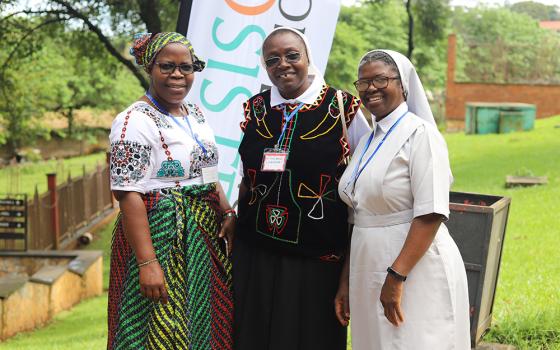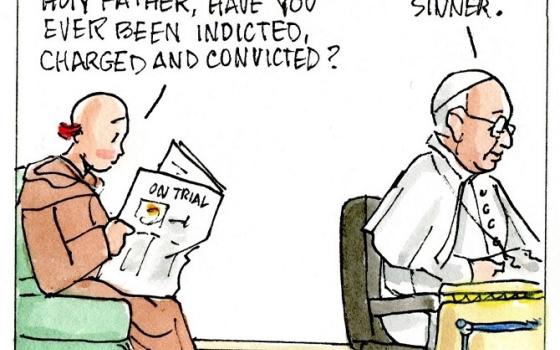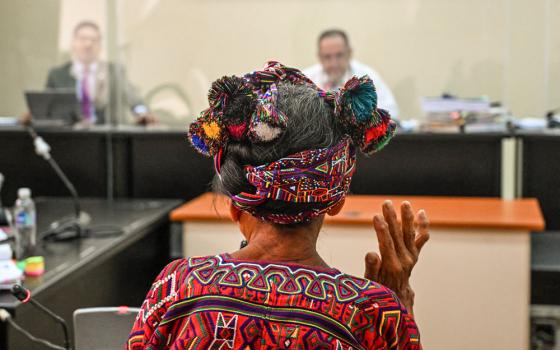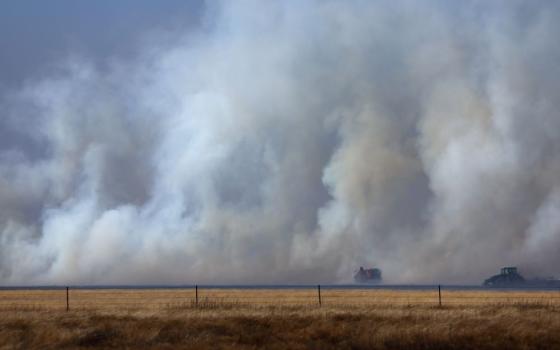
NEWARK, N.J. -- The Cathedral Basilica of the Sacred Heart in downtown Newark, one of the largest in the country, is a magnificent testament to the Catholic presence in this beleaguered city.
The grand, block-long sweep of its Vermont granite, which includes a cathedral rectory, is visible through a large round window in the office of Archbishop John J. Myers. He refers to the cathedral during an interview as "one of the great churches in the Western Hemisphere."
It is all at once a sign of constancy as well as a symbol of a church of another era, of a previous Catholic age, of an earlier immigrant experience. These are not the days for big brick-and-mortar dreams. This is the time of a new immigrant church made up of the poor, and often undocumented, from all over the world. The globalized church takes on an urgent reality in these Newark streets, scarred by America’s racial sins and the ravages of urban poverty.
In the century and a half since the idea of a grand cathedral was first proposed in 1859 (it wasn’t until 1881 that “the project actually got off the ground,” according to a Web site devoted to its history) and in the 55 years since it was dedicated, the changes in this city and the church here have been so dramatic that the cathedral might be one of the few remaining elements recognizable to those early church builders.
The history of the cathedral is replete with ties to Western Europe and that continent’s influence on its sons and daughters in the New World. The initial dreamers traveled to Germany, France and England to gather ideas for the new structure, meeting in England with proponents of neo-Gothic revival. It was all very white and echoed loudly the tones of Irish and even Anglican religious experience.
The Catholic community today in this city and many of its nearby environs is largely a brown palette, where the shades range from light coffee to deep dark chocolate. The people are from everywhere; the diversity to this visitor was almost overwhelming.
It would be difficult to overstate this matter of diversity. During a several-day period, I met Fr. Josephat Kato Kalema, a pastor and native of Uganda who arrived here by way, partly, of a Trappist monastery in Kenya; met another, Fr. Luis P. Gonzalez, from southern Spain; heard about a priest, a native of El Salvador, who arrived in the area about 15 years ago as an illegal refugee, went to high school, managed to become a citizen along the way, and decided to become a priest; interviewed a young Austrian priest, Andreas Hellmann, who is pastor of a Latin Mass chapel; corresponded by e-mail (we couldn’t find a mutual meeting time) with Fr. Giovanni Rizzo, an Italian who’s associated with the Neocatechumenate movement; and visited a rectory where five employees were from five different countries, all first generation.
The presumption in some parishes is that a large percentage of the congregation is made up of undocumented immigrants. The immigrant detention center in Elizabeth is a constant point of reference and ministry for some parishes and Catholic social outreach agencies.
Diversity doesn’t stop at the episcopal level. Auxiliary Bishop Edgar da Cunha of Brazil joined Myers during a 45-minute interview at the archbishop’s office.
Said Myers, “The Lord said, ‘Go and carry the Gospel to all nations.’ All the nations came to us. We get to learn to live with that.”
(Editor’s Note: Next in the “In Search of the Emerging Church” series is an extended interview with Bishops Myers and da Cunha.)
 Dynamics of an archdiocese
Dynamics of an archdiocese
It is impossible, of course, in little more than a week’s time, to fully understand the dynamics of an archdiocese, especially one as widely varied, as densely layered and as quickly changing as Newark. It is the smallest archdiocese in the country in terms of land mass -- a total of four counties covering 511 square miles -- but the ninth-largest in terms of Catholic population.
“In Illinois I had 26 counties. It was 17,000 square miles, and the whole state of New Jersey is only 15,000 square miles,” remarked Myers, an Illinois native who was bishop of the Peoria diocese from 1990 to 2001, when he was appointed archbishop here. In all that acreage back in Illinois, however, there are only 169,375 Catholics, or 12 percent of the population, according to figures from the Center for Applied Research in the Apostolate at Georgetown University in Washington. Newark’s 1.3 million Catholics comprise 47 percent of the nearly 3 million total population of the archdiocese. The region is very Catholic and, given the uncertainty about undocumented, the actual number of Catholics could be considerably higher.
It isn’t possible, either, to see clearly what is emerging. People who are in the middle of it, who are ministering to what’s new -- to the waves of Haitians, Mexicans, Salvadorans, Nigerians, Indians and others -- aren’t certain where it’s all headed.
Like other dioceses, Newark is going through an extensive reorganization under a process called New Energies. Unlike many other places, it is not driven by a priest shortage but rather by a lack of money. Myers said the archdiocese for years has pumped millions into inner-city parishes and schools to keep them afloat. He said he’s had to tell pastors that the archdiocese can’t continue such regular subsidies indefinitely, and he’s involved parishes in a wide and lengthy consultation to come up with a realignment that is sustainable.
Financial difficulties notwithstanding, it seems reasonable to imagine that Newark could be one of those places pointing to the future, though an anomaly of sorts on the Catholic landscape. This is an archdiocese that is priest-rich and where the churches, while abandoned by previous generations of European immigrants, keep filling with new waves of those from other countries. This is not a church in the city that has permanently emptied out, according to a number of people I interviewed. It is more a church in the city with an ever-shifting and very poor and often undocumented membership.
“I’ll say a couple of things that we can foresee happening,” said da Cunha, who heads the New Energies effort. “One is we’re no longer going to have the ethnic churches and national churches as we used to have: the Polish church here, the Italian church here and the German church here. So now we have more integration. We have a parish that has Mass in Italian, Spanish, Portuguese, English and Korean.”
While the archdiocese has plenty of priests, more than the number of parishes, many are from other countries, said da Cunha. “I think that integration brings the new dimension to the church. We have also seen, and we are working towards people seeing a wider view of church rather than ‘My little world here. My parish is my little world and we are self-contained here.’
“We are trying to help people look beyond that parochial vision of ‘It’s just my parish, leave me alone with it.’ We have people exchanging ministries and parishes exchanging ministries, reaching out to others. Suburban parishes are reaching out to inner-city parishes, and inner-city parishes are sharing ministries with other suburban parishes. There is that view of the church as more than just the small cluster of a parish.”
In some ways, da Cunha’s view is in step with what is already underway. Not only are static ethnic parishes a relic of the past. Gone, too, are territorial parishes. People go where they want to go, where they find the right “fit” or the characteristics of community that they find most appealing. I asked da Cunha if we are headed toward a church that is less territorial and more driven by mission and culture.
“The territory today doesn’t mean a whole lot for people as it used to. People go to church where they feel comfortable, where they want, where the language works or whatever. If you told people 50 years ago, ‘I come from Brooklyn,’ they’d say, ‘What parish?’ That was what people identified with.” Today, however, if you ask people where they live, “they’ll say, ‘I live in Hoboken, but I go to Mass in Weehawken,’ or ‘I live in Bloomfield but I go to Mass in Nutley.’ This has been all over the place so boundaries are really becoming less and less significant for people,” da Cunha said.
Asked if there were any chance of enforcing boundaries, Myers responded: “We couldn’t possibly do it.”
A global face
Mark J. Bonamo is a 39-year-old Catholic and managing editor of the Hackensack Chronicle who sees the future of the church in the very mix of immigrants, the undocumented and the poor who make up much of the archdiocese.
Bonamo is also one of those non-territorial Catholics. He lives in Newark’s Ironbound section but he’s a member of Our Lady of Czestochowa Church, a revived parish with an unusually young demographic in nearby Jersey City.
In a phone interview, he said he was attracted to the parish because it had an element of the traditional -- “You could still see the Black Madonna above the altar” -- but also “a diverse population in the pews,” older Polish families in what once was an exclusively Polish parish as well as “young families and younger single people.”
He thinks the diversity of Newark and other cities such as Jersey City, Elizabeth and Hoboken, with a mix of young professionals oriented toward New York and newcomers trying to find their way, is simply a characteristic of the region. Jersey City, he notes, “is within the shadow of Ellis Island,” so that immigrants and immigrant issues are part of the fiber of the region.
The four counties that make up the diocese attract immigrants, he believes, “because of their densely urban nature, the potential for jobs” and the fact that people here are far less concerned than elsewhere about immigrants in their midst.
Asked about the ask-no-questions policy the church has adopted here regarding undocumented aliens, he said, “As a Catholic and a journalist, I think that is a good model to follow.” He believes the church should be deeply involved in advocating legislation that would help illegal immigrants along a path to citizenship.
“The Catholic church both globally and locally is moving away from a kind of Eurocentric atmosphere to a more global -- not that the church wasn’t always global, but it is going to have a more global face. That’s just a worldwide trend,” he said.
Perhaps the builders of the cathedral and the ethnic churches whose walls now hold the faces and stories of the new immigrants would understand that sentiment perfectly.
 ------------------------------------------------------------------------------
------------------------------------------------------------------------------
Tom Roberts, NCR editor at large, is traveling the country reporting on parish life. He is on the first of several trips he plans to take, this time moving through Ohio, eastward into New Jersey and on to the nation’s capital. His e-mail address is troberts@ncronline.org. Read the full series here: In Search of the Emerging Church.
--------------------------------------------------------------------------------
Follow Tom Roberts on his journey "In Search of the Emerging Church." Sign up to receive an e-mail alert when his stories are posted to this series. If you already receive e-mail alerts from NCR, click on the button that says "update my profile."
--------------------------------------------------------------------------------
Web sites




